Implementation of an ERP System for a Food Delivery Company
VerifiedAdded on 2023/06/05
|6
|1112
|318
Report
AI Summary
This report analyzes the implementation of an Enterprise Resource Planning (ERP) system for a food delivery business operating in Melbourne. The business, which focuses on home, office, and event food deliveries, currently relies on phone orders and seeks to improve efficiency and customer service through an online ERP system. The report details the ERP architecture, including a two-tier system for order processing and delivery notifications. It examines key ERP modules such as inventory and sales, outlining their functions in managing stock and handling customer orders. The benefits of the ERP system are highlighted, including improved reporting, increased productivity, and streamlined order processing. The report also addresses potential limitations, such as the need for employee training and initial investment costs. Finally, it explores current ERP trends, such as integrating blockchain technology for supply chain management, and concludes that the ERP system is crucial for the company's future growth and profitability.
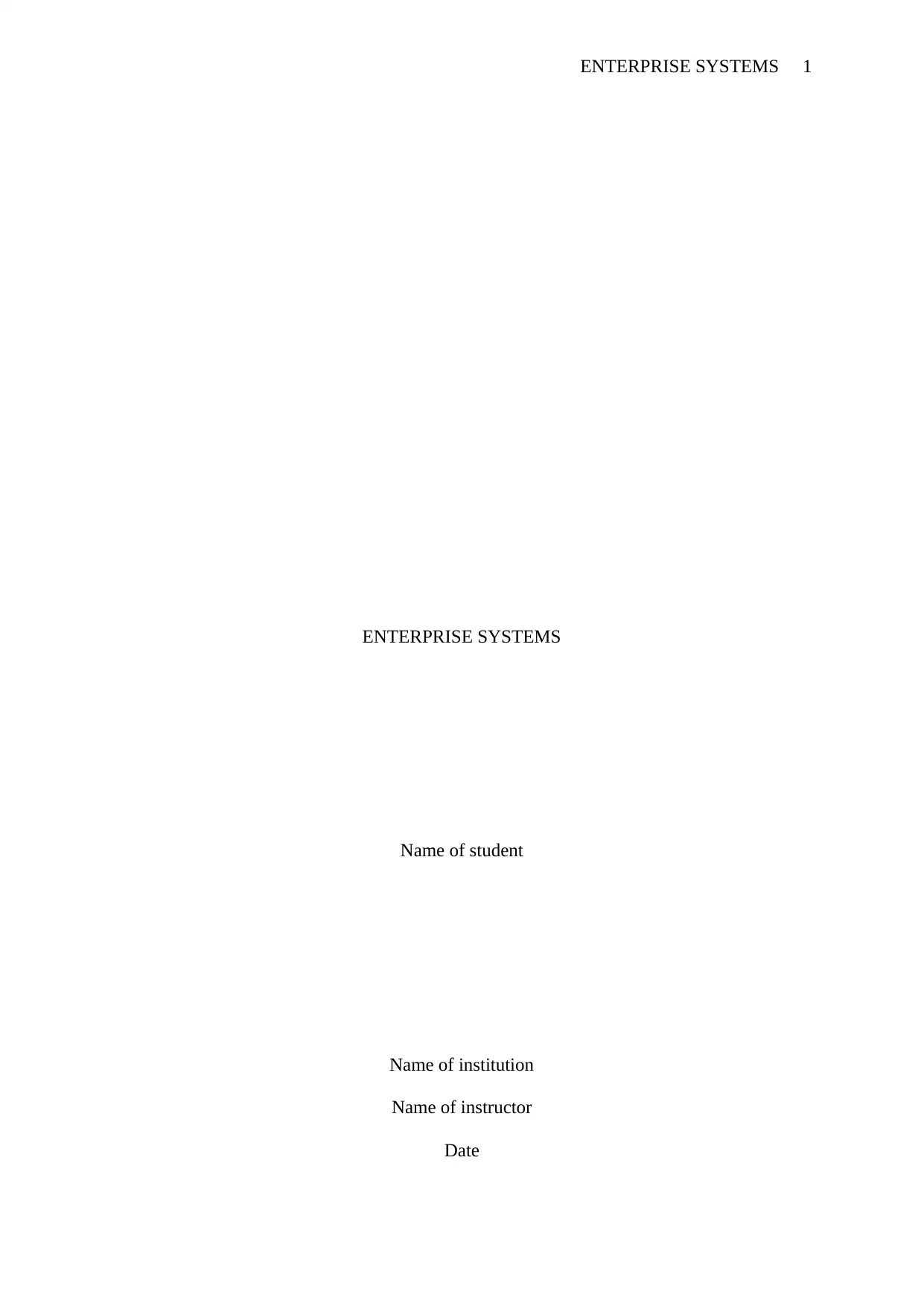
ENTERPRISE SYSTEMS 1
ENTERPRISE SYSTEMS
Name of student
Name of institution
Name of instructor
Date
ENTERPRISE SYSTEMS
Name of student
Name of institution
Name of instructor
Date
Paraphrase This Document
Need a fresh take? Get an instant paraphrase of this document with our AI Paraphraser
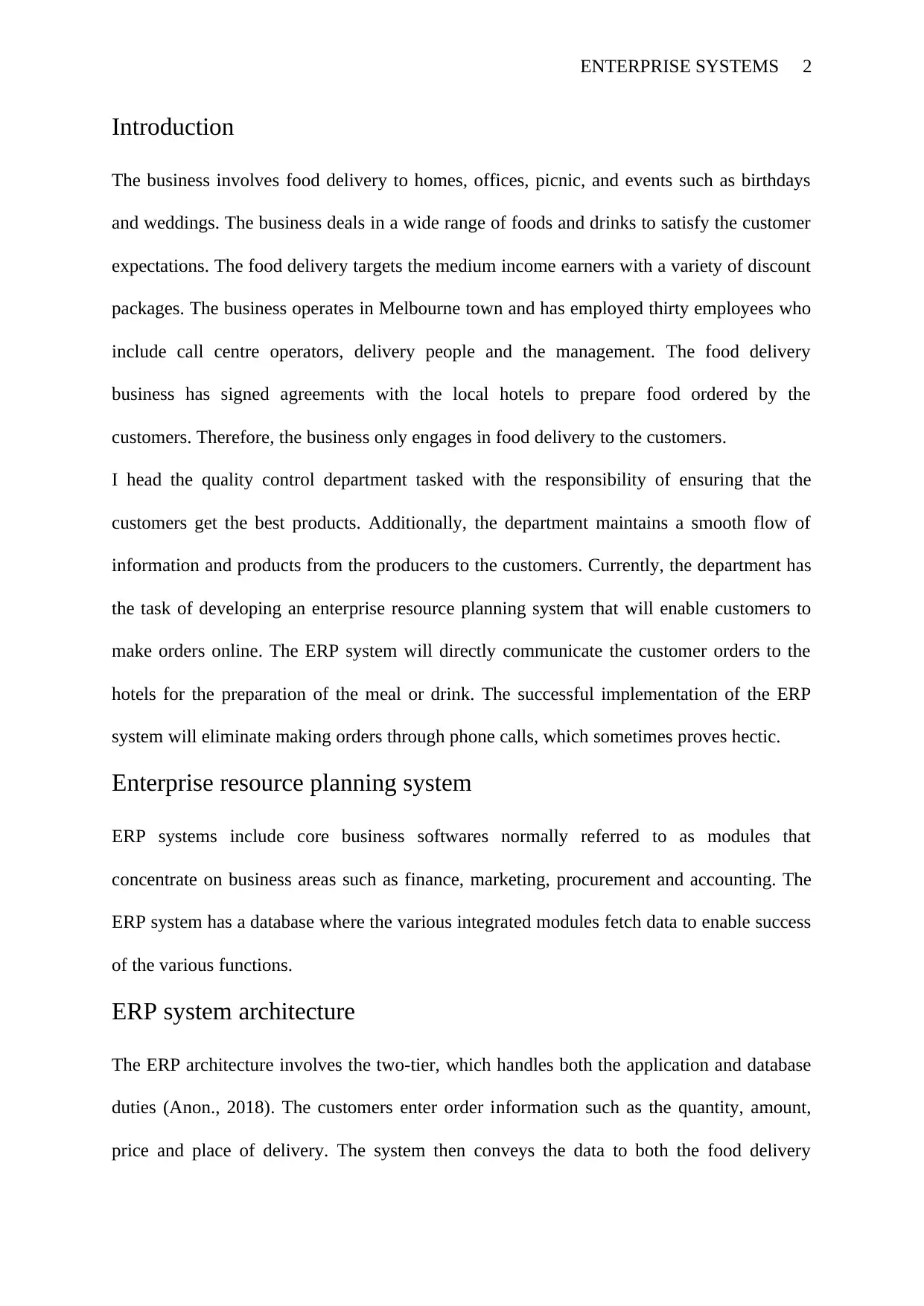
ENTERPRISE SYSTEMS 2
Introduction
The business involves food delivery to homes, offices, picnic, and events such as birthdays
and weddings. The business deals in a wide range of foods and drinks to satisfy the customer
expectations. The food delivery targets the medium income earners with a variety of discount
packages. The business operates in Melbourne town and has employed thirty employees who
include call centre operators, delivery people and the management. The food delivery
business has signed agreements with the local hotels to prepare food ordered by the
customers. Therefore, the business only engages in food delivery to the customers.
I head the quality control department tasked with the responsibility of ensuring that the
customers get the best products. Additionally, the department maintains a smooth flow of
information and products from the producers to the customers. Currently, the department has
the task of developing an enterprise resource planning system that will enable customers to
make orders online. The ERP system will directly communicate the customer orders to the
hotels for the preparation of the meal or drink. The successful implementation of the ERP
system will eliminate making orders through phone calls, which sometimes proves hectic.
Enterprise resource planning system
ERP systems include core business softwares normally referred to as modules that
concentrate on business areas such as finance, marketing, procurement and accounting. The
ERP system has a database where the various integrated modules fetch data to enable success
of the various functions.
ERP system architecture
The ERP architecture involves the two-tier, which handles both the application and database
duties (Anon., 2018). The customers enter order information such as the quantity, amount,
price and place of delivery. The system then conveys the data to both the food delivery
Introduction
The business involves food delivery to homes, offices, picnic, and events such as birthdays
and weddings. The business deals in a wide range of foods and drinks to satisfy the customer
expectations. The food delivery targets the medium income earners with a variety of discount
packages. The business operates in Melbourne town and has employed thirty employees who
include call centre operators, delivery people and the management. The food delivery
business has signed agreements with the local hotels to prepare food ordered by the
customers. Therefore, the business only engages in food delivery to the customers.
I head the quality control department tasked with the responsibility of ensuring that the
customers get the best products. Additionally, the department maintains a smooth flow of
information and products from the producers to the customers. Currently, the department has
the task of developing an enterprise resource planning system that will enable customers to
make orders online. The ERP system will directly communicate the customer orders to the
hotels for the preparation of the meal or drink. The successful implementation of the ERP
system will eliminate making orders through phone calls, which sometimes proves hectic.
Enterprise resource planning system
ERP systems include core business softwares normally referred to as modules that
concentrate on business areas such as finance, marketing, procurement and accounting. The
ERP system has a database where the various integrated modules fetch data to enable success
of the various functions.
ERP system architecture
The ERP architecture involves the two-tier, which handles both the application and database
duties (Anon., 2018). The customers enter order information such as the quantity, amount,
price and place of delivery. The system then conveys the data to both the food delivery
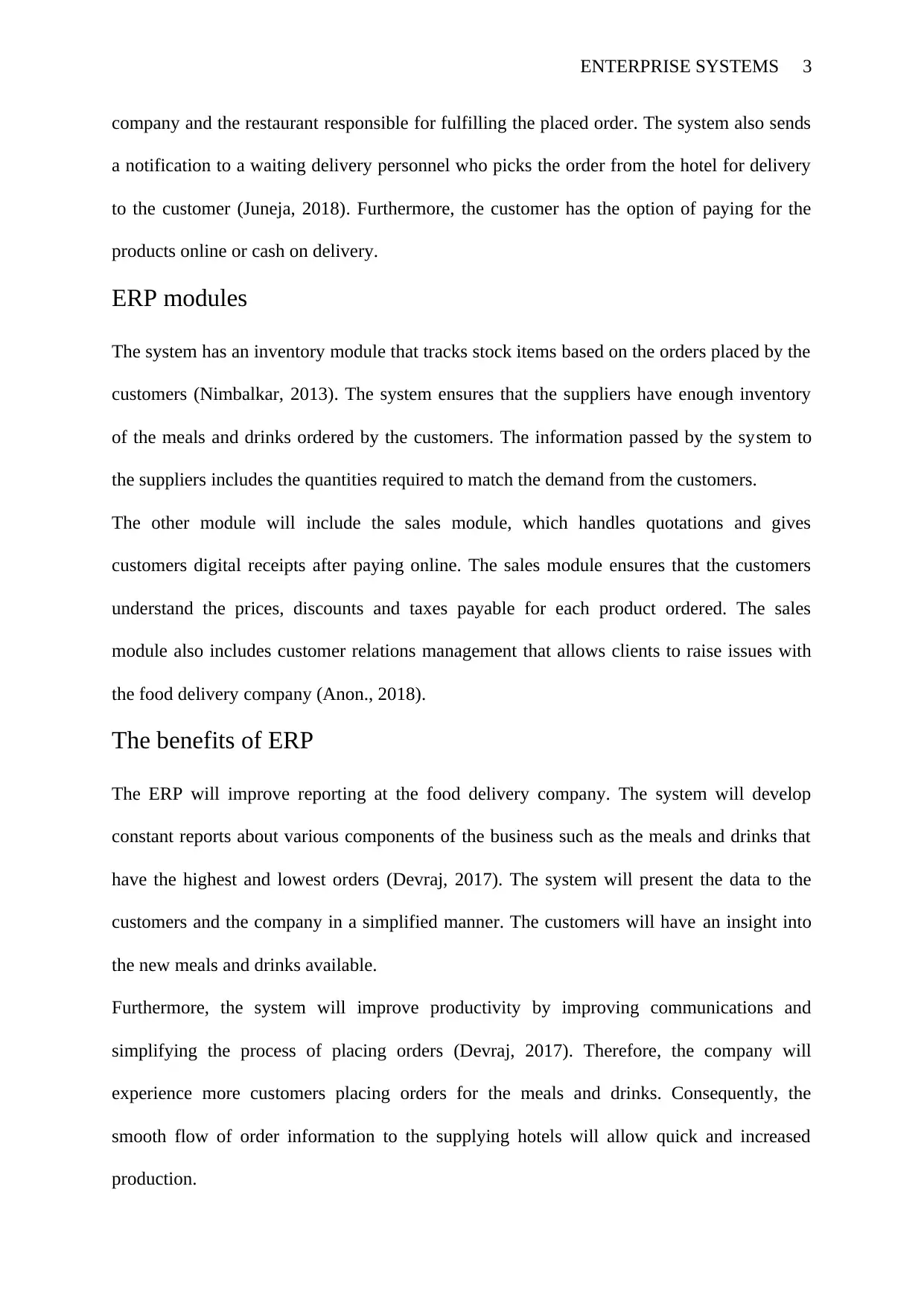
ENTERPRISE SYSTEMS 3
company and the restaurant responsible for fulfilling the placed order. The system also sends
a notification to a waiting delivery personnel who picks the order from the hotel for delivery
to the customer (Juneja, 2018). Furthermore, the customer has the option of paying for the
products online or cash on delivery.
ERP modules
The system has an inventory module that tracks stock items based on the orders placed by the
customers (Nimbalkar, 2013). The system ensures that the suppliers have enough inventory
of the meals and drinks ordered by the customers. The information passed by the system to
the suppliers includes the quantities required to match the demand from the customers.
The other module will include the sales module, which handles quotations and gives
customers digital receipts after paying online. The sales module ensures that the customers
understand the prices, discounts and taxes payable for each product ordered. The sales
module also includes customer relations management that allows clients to raise issues with
the food delivery company (Anon., 2018).
The benefits of ERP
The ERP will improve reporting at the food delivery company. The system will develop
constant reports about various components of the business such as the meals and drinks that
have the highest and lowest orders (Devraj, 2017). The system will present the data to the
customers and the company in a simplified manner. The customers will have an insight into
the new meals and drinks available.
Furthermore, the system will improve productivity by improving communications and
simplifying the process of placing orders (Devraj, 2017). Therefore, the company will
experience more customers placing orders for the meals and drinks. Consequently, the
smooth flow of order information to the supplying hotels will allow quick and increased
production.
company and the restaurant responsible for fulfilling the placed order. The system also sends
a notification to a waiting delivery personnel who picks the order from the hotel for delivery
to the customer (Juneja, 2018). Furthermore, the customer has the option of paying for the
products online or cash on delivery.
ERP modules
The system has an inventory module that tracks stock items based on the orders placed by the
customers (Nimbalkar, 2013). The system ensures that the suppliers have enough inventory
of the meals and drinks ordered by the customers. The information passed by the system to
the suppliers includes the quantities required to match the demand from the customers.
The other module will include the sales module, which handles quotations and gives
customers digital receipts after paying online. The sales module ensures that the customers
understand the prices, discounts and taxes payable for each product ordered. The sales
module also includes customer relations management that allows clients to raise issues with
the food delivery company (Anon., 2018).
The benefits of ERP
The ERP will improve reporting at the food delivery company. The system will develop
constant reports about various components of the business such as the meals and drinks that
have the highest and lowest orders (Devraj, 2017). The system will present the data to the
customers and the company in a simplified manner. The customers will have an insight into
the new meals and drinks available.
Furthermore, the system will improve productivity by improving communications and
simplifying the process of placing orders (Devraj, 2017). Therefore, the company will
experience more customers placing orders for the meals and drinks. Consequently, the
smooth flow of order information to the supplying hotels will allow quick and increased
production.
⊘ This is a preview!⊘
Do you want full access?
Subscribe today to unlock all pages.

Trusted by 1+ million students worldwide
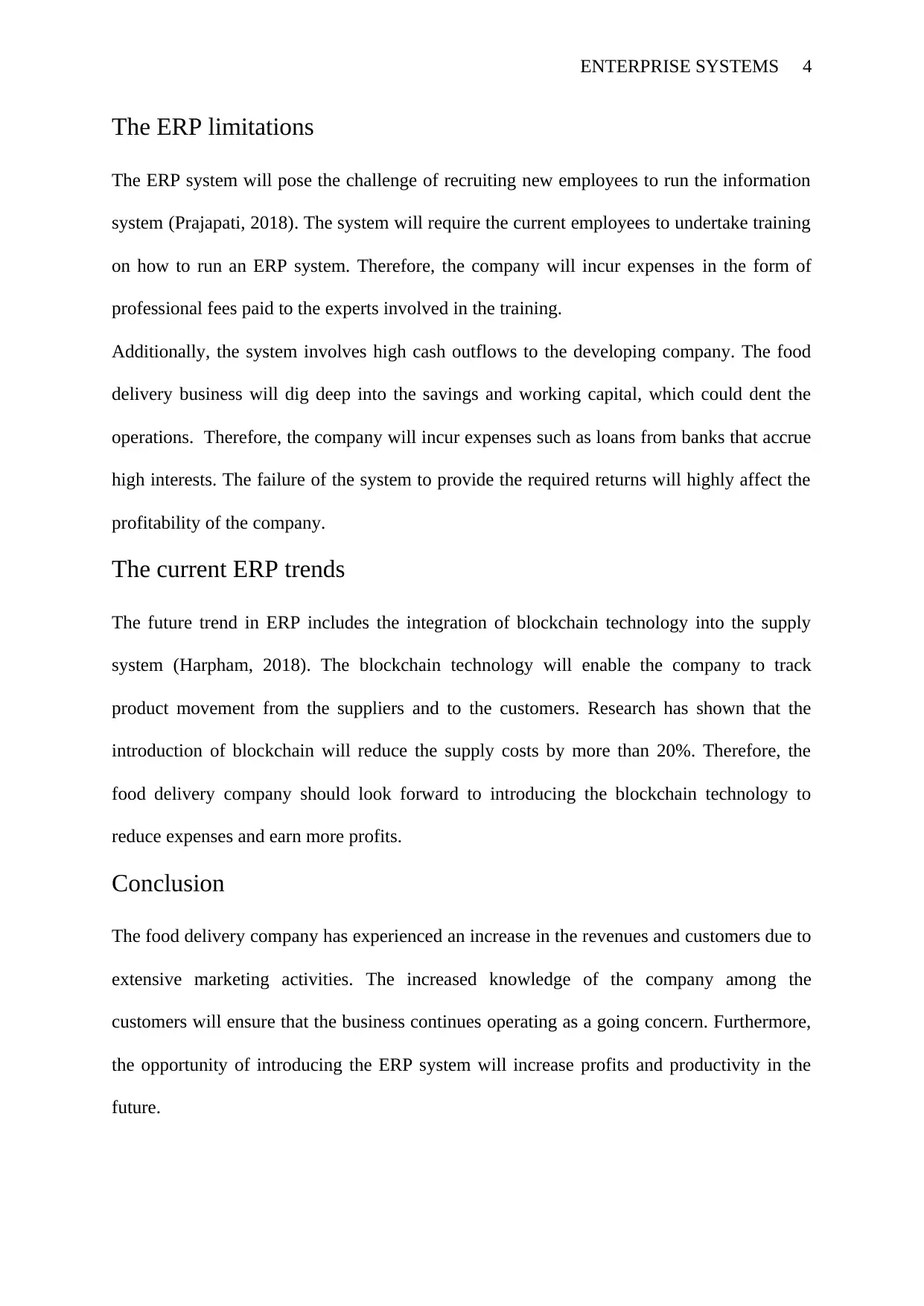
ENTERPRISE SYSTEMS 4
The ERP limitations
The ERP system will pose the challenge of recruiting new employees to run the information
system (Prajapati, 2018). The system will require the current employees to undertake training
on how to run an ERP system. Therefore, the company will incur expenses in the form of
professional fees paid to the experts involved in the training.
Additionally, the system involves high cash outflows to the developing company. The food
delivery business will dig deep into the savings and working capital, which could dent the
operations. Therefore, the company will incur expenses such as loans from banks that accrue
high interests. The failure of the system to provide the required returns will highly affect the
profitability of the company.
The current ERP trends
The future trend in ERP includes the integration of blockchain technology into the supply
system (Harpham, 2018). The blockchain technology will enable the company to track
product movement from the suppliers and to the customers. Research has shown that the
introduction of blockchain will reduce the supply costs by more than 20%. Therefore, the
food delivery company should look forward to introducing the blockchain technology to
reduce expenses and earn more profits.
Conclusion
The food delivery company has experienced an increase in the revenues and customers due to
extensive marketing activities. The increased knowledge of the company among the
customers will ensure that the business continues operating as a going concern. Furthermore,
the opportunity of introducing the ERP system will increase profits and productivity in the
future.
The ERP limitations
The ERP system will pose the challenge of recruiting new employees to run the information
system (Prajapati, 2018). The system will require the current employees to undertake training
on how to run an ERP system. Therefore, the company will incur expenses in the form of
professional fees paid to the experts involved in the training.
Additionally, the system involves high cash outflows to the developing company. The food
delivery business will dig deep into the savings and working capital, which could dent the
operations. Therefore, the company will incur expenses such as loans from banks that accrue
high interests. The failure of the system to provide the required returns will highly affect the
profitability of the company.
The current ERP trends
The future trend in ERP includes the integration of blockchain technology into the supply
system (Harpham, 2018). The blockchain technology will enable the company to track
product movement from the suppliers and to the customers. Research has shown that the
introduction of blockchain will reduce the supply costs by more than 20%. Therefore, the
food delivery company should look forward to introducing the blockchain technology to
reduce expenses and earn more profits.
Conclusion
The food delivery company has experienced an increase in the revenues and customers due to
extensive marketing activities. The increased knowledge of the company among the
customers will ensure that the business continues operating as a going concern. Furthermore,
the opportunity of introducing the ERP system will increase profits and productivity in the
future.
Paraphrase This Document
Need a fresh take? Get an instant paraphrase of this document with our AI Paraphraser
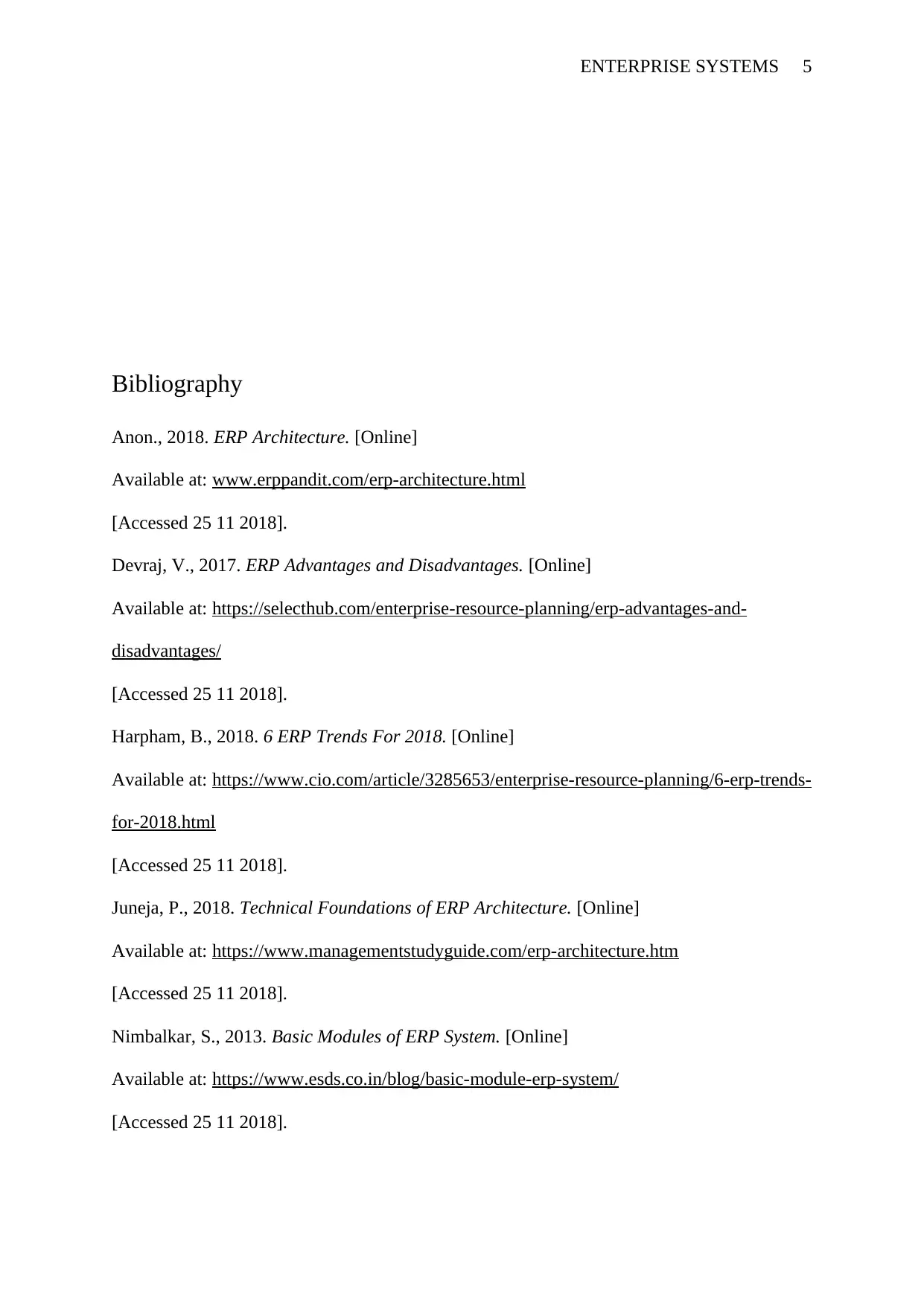
ENTERPRISE SYSTEMS 5
Bibliography
Anon., 2018. ERP Architecture. [Online]
Available at: www.erppandit.com/erp-architecture.html
[Accessed 25 11 2018].
Devraj, V., 2017. ERP Advantages and Disadvantages. [Online]
Available at: https://selecthub.com/enterprise-resource-planning/erp-advantages-and-
disadvantages/
[Accessed 25 11 2018].
Harpham, B., 2018. 6 ERP Trends For 2018. [Online]
Available at: https://www.cio.com/article/3285653/enterprise-resource-planning/6-erp-trends-
for-2018.html
[Accessed 25 11 2018].
Juneja, P., 2018. Technical Foundations of ERP Architecture. [Online]
Available at: https://www.managementstudyguide.com/erp-architecture.htm
[Accessed 25 11 2018].
Nimbalkar, S., 2013. Basic Modules of ERP System. [Online]
Available at: https://www.esds.co.in/blog/basic-module-erp-system/
[Accessed 25 11 2018].
Bibliography
Anon., 2018. ERP Architecture. [Online]
Available at: www.erppandit.com/erp-architecture.html
[Accessed 25 11 2018].
Devraj, V., 2017. ERP Advantages and Disadvantages. [Online]
Available at: https://selecthub.com/enterprise-resource-planning/erp-advantages-and-
disadvantages/
[Accessed 25 11 2018].
Harpham, B., 2018. 6 ERP Trends For 2018. [Online]
Available at: https://www.cio.com/article/3285653/enterprise-resource-planning/6-erp-trends-
for-2018.html
[Accessed 25 11 2018].
Juneja, P., 2018. Technical Foundations of ERP Architecture. [Online]
Available at: https://www.managementstudyguide.com/erp-architecture.htm
[Accessed 25 11 2018].
Nimbalkar, S., 2013. Basic Modules of ERP System. [Online]
Available at: https://www.esds.co.in/blog/basic-module-erp-system/
[Accessed 25 11 2018].
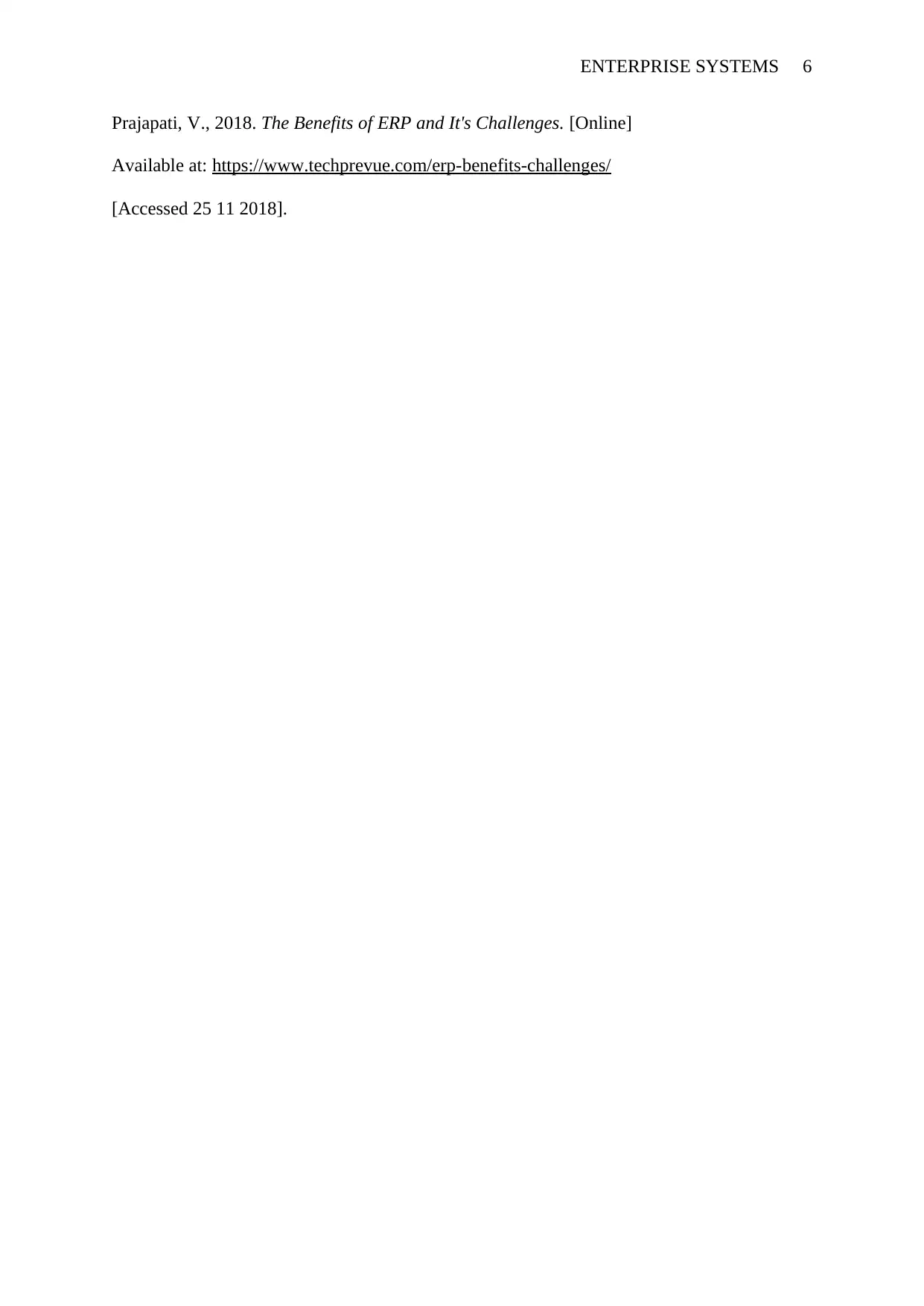
ENTERPRISE SYSTEMS 6
Prajapati, V., 2018. The Benefits of ERP and It's Challenges. [Online]
Available at: https://www.techprevue.com/erp-benefits-challenges/
[Accessed 25 11 2018].
Prajapati, V., 2018. The Benefits of ERP and It's Challenges. [Online]
Available at: https://www.techprevue.com/erp-benefits-challenges/
[Accessed 25 11 2018].
⊘ This is a preview!⊘
Do you want full access?
Subscribe today to unlock all pages.

Trusted by 1+ million students worldwide
1 out of 6
Related Documents
Your All-in-One AI-Powered Toolkit for Academic Success.
+13062052269
info@desklib.com
Available 24*7 on WhatsApp / Email
![[object Object]](/_next/static/media/star-bottom.7253800d.svg)
Unlock your academic potential
Copyright © 2020–2025 A2Z Services. All Rights Reserved. Developed and managed by ZUCOL.




